
Gilia clivorum is a species of flowering plant in the phlox family known by the common names purplespot gilia and many-stemmed gilia. It is native to California and Arizona.

Gilia scopulorum is a species of flowering plant in the phlox family known by the common names rock gilia and Rocky Mountain gilia. It is native to the Mojave and Sonoran Deserts.

Horkelia marinensis is a rare species of flowering plant in the rose family known by the common name Point Reyes horkelia. It is endemic to the California coastline, where it is known from about Fort Bragg to near Santa Cruz. It grows on beaches and in other sandy coastal areas. This is a perennial herb growing in low, dense patches. The leaves are up to 10 centimeters long and are made up of toothed, hairy, gray-green leaflets each around a centimeter long. The foliage is glandular and strongly scented. The plant produces green to reddish-green stems up to 30 centimeters long which bear inflorescences of dense clustered flowers. Each flower has minute bractlets under reddish-green, fuzzy sepals. The petals are generally white and narrow with rounded ends. The center of the flower contains a ring of stamens around a patch of 20 to 30 pistils.
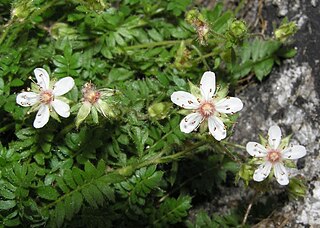
Ivesia callida is a rare species of flowering plant, in the rose family, known by the common name Tahquitz mousetail. It is a small perennial herb which forms matted patches of hanging foliage on cliff faces. The leaves are strips of oval-shaped green leaflets. Each leaf is up to 7 centimeters long and has several pairs of hairy, glandular leaflets. The thin, green, hanging stems grow up to 15 centimeters long and bear an inflorescence of several flowers. Each flower has five hairy, pointed sepals and five round to oval white petals. The center of the flower contains twenty stamens with disc-shaped anthers and several pistils.

Astragalus acutirostris is a species of milkvetch known by the common name sharpkeel milkvetch. It is native to the Mojave Desert and surroundings of California, Nevada, and Arizona, where it grows in dry, sandy, gravelly areas.

Astragalus layneae is a species of milkvetch known by the common name widow's milkvetch. It is native to the Mojave Desert and surrounding mountain ridges in California and Nevada.
Astragalus monoensis is a rare species of milkvetch known by the common name Mono milkvetch. It is endemic to the open pumice plains of central Mono County, California.

Astragalus nuttallii is a species of milkvetch known by the common name Nuttall's milkvetch. It is native to California and Baja California, where it grows in the sandy soils of coastal habitat. This is a perennial herb forming thick, tangled clumps of hairy to hairless stems up to a meter in length. The abundant leaves are up to 17 centimeters in length and made up of many oval-shaped leaflets. The inflorescence is a large, dense body of up to 125 flowers, each around 1 to 1.5 centimeters long. The flowers are dull cream-colored and sometimes purple-tinted. The fruit is an inflated legume pod up to 6 centimeters long which dries to a papery texture and contains many seeds in its single chamber. One variety of this species, the ocean bluff milkvetch is endemic to the Central Coast of California.

Astragalus shevockii is a rare species of milkvetch known by the common names Little Kern milkvetch and Shevock's milkvetch. It is endemic to Tulare County, California, where it grows in the High Sierra, generally on granite-based soils in Jeffrey pine forests.
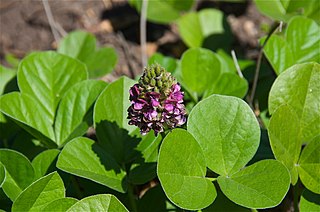
Hoita orbicularis is a species of legume known by the common name roundleaf leather-root. It is endemic to California, where it is relatively widespread throughout the state's mountain ranges, growing most often in moist habitat. It is a perennial herb growing prostrate or nearly so at ground level with large leaves each made up of three round leaflets up to 11 centimetres long each. The herbage is glandular and often hairy. The inflorescence is an erect raceme which may be up to 35 centimetres long. Each of the many flowers is one or two centimeters long, pealike, and generally a shade of light to medium purple in color. The fruit is a hairy, veiny legume pod just under 1 centimetre long.

Hoita strobilina is a rare species of legume known by the common name Loma Prieta leatherroot, or Loma Prieta hoita. It is endemic to California, where it is known from occasional occurrences in the San Francisco Bay Area. It grows in chaparral and woodland habitat in the local mountains, often on serpentine soil. This is a perennial herb growing erect, approaching a meter in maximum height. The large leaves are divided into three leaflets each up to 8 centimeters long and lance-shaped to nearly round. The herbage is generally glandular and hairy. The inflorescence is a raceme up to 13 centimeters long containing many pealike flowers. Each flower is purple, sometimes with white parts, and one to two centimeters long. The fruit is a dark brown or black, hairy, veiny legume pod.
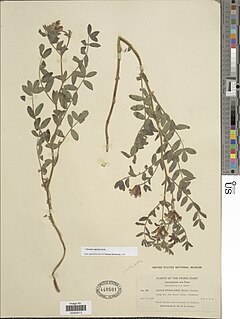
Hosackia stipularis, synonym Lotus stipularis, is a species of legume endemic to California. It is known by the common name balsam bird's-foot trefoil. It is found in most of the northern and central coastal and inland mountain ranges and foothills. It can be found in many types of habitat, including forest, chaparral, and disturbed areas. This is a mostly erect perennial herb with a leafy, often hairy and glandular form. Its slender branches are lined with leaves each made of several leaflets up to 2 centimeters long. The leaves sometimes have prominent stipules. The inflorescence is a compact array of up to 9 pink flowers. Each flower is elongated, the corolla borne in a tubular calyx of sepals, and the entire unit may exceed a centimeter long. The fruit is a legume pod 2 or 3 centimeters long containing several beanlike seeds.
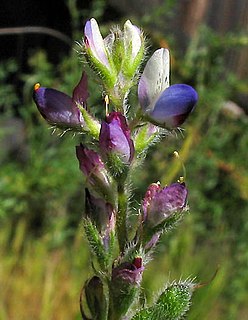
Lupinus concinnus is a species of lupine known by the common name Bajada lupine. It is native to the southwestern United States from California to Texas, and northern Mexico, where it is known from many types of habitat. This is a hairy erect or decumbent annual herb with a stem growing 10 to 30 centimeters long. Each small palmate leaf is made up of 5 to 9 leaflets up to 3 centimeters long and under a centimeter wide, sometimes narrow and linear in shape. The inflorescence is a dense spiral of flowers, with some flowers also appearing in leaf axils lower on the plant. Each flower is 5 to 12 millimeters long and purple, pink, or nearly white in color. The fruit is a hairy legume pod around a centimeter long.
Pediomelum castoreum is a species of flowering plant in the legume family known by the common names beaver Indian breadroot and beaver dam breadroot. It is native to the deserts around the intersection of California, Nevada, and Arizona, where it grows in local habitat including disturbed areas. It is a perennial herb with no stem or a short stem that is mostly underground, leaving the plant at ground level. The compound leaves are each made up of five or six oval leaflets which may be over 4 centimeters long. The leaf is borne on a long petiole. The inflorescence is a raceme of several blue or purple pealike flowers each roughly a centimeter long. The fruit is a hairy oval legume pod tipped with a long, curved beak. It contains ridged gray seeds each about 6 millimeters long.
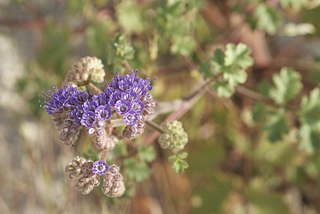
Phacelia pedicellata is a species of flowering plant in the borage family, Boraginaceae. Its common names include specter phacelia and pedicellate phacelia. It is native to the southwestern United States and Baja California, where it can be found in several types of habitat, including creosote bush scrub and Joshua tree woodland.

Psoralidium lanceolatum is a species of flowering plant in the legume family known by several common names, including lemon scurfpea, wild lemonweed, and dune scurfpea.

Psorothamnus schottii is a species of flowering plant in the legume family known by the common name Schott's dalea. It is native to the Sonoran Deserts of northern Mexico and adjacent sections of Arizona and the Colorado Desert in California.
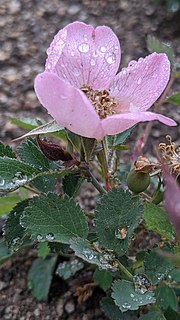
Rosa bridgesii is a species of rose known by the common names pygmy rose and Sierran dwarf rose. It is native to California, where it grows in the forests of the Sierra Nevada and surrounding mountains and foothills. It may also occur in Oregon.
Rupertia rigida is a species of flowering plant in the legume family known by the common name Parish's California tea, or Parish's rupertia.
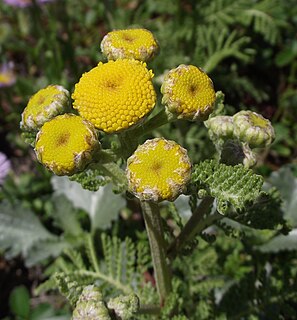
Tanacetum camphoratum is a species of flowering plant in the aster family known by the common names camphor tansy and dune tansy. It is native to the Pacific Coast of North America from British Columbia to California, where it grows in sand dunes and other coastline habitat. This species may be known by the synonym Tanacetum douglasii and is often included in Tanacetum bipinnatum. It is a rhizomatous perennial herb with a thick, low-lying stem up to 25 centimeters long, branching to form a mass of vegetation. It is hairy, glandular, and aromatic, with a camphor scent. The leaves are up to 25 centimeters long and thick but featherlike, divided into many narrow leaflets on each side of the main rachis. Each leaflet in turn has many segments along each side, and the segments are usually divided into several small, knobby segments with folded or curled edges. The inflorescence bears up to 15 flower heads, each about a centimeter wide or slightly wider. Each head contains many yellowish disc florets and many pistillate florets around the edges. The latter may have minute ray florets. The fruit is an achene a few millimeters long which is tipped with a small pappus of toothed scales.

















